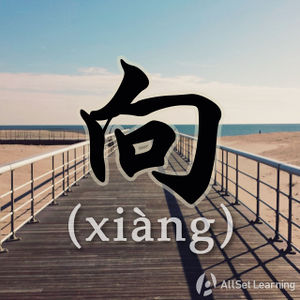Difference between revisions of "Expressing "towards" with "xiang""
| Line 17: | Line 17: | ||
<div class="liju"> | <div class="liju"> | ||
| − | * | + | *她 一直 <em>向</em> 我 招手。<span class="trans">She kept waving to me.</span> |
*我们 需要 <em>向</em> 他 道歉。<span class="trans">We need to apologize to him.</span> | *我们 需要 <em>向</em> 他 道歉。<span class="trans">We need to apologize to him.</span> | ||
| − | * | + | *老师正 <em>向</em> 我们走来。<span class="trans">The teacher is walking up to us.</span> |
*我 要 <em>向</em> 你 学习!<span class="trans">I want to learn from you.</span> | *我 要 <em>向</em> 你 学习!<span class="trans">I want to learn from you.</span> | ||
Revision as of 01:23, 23 August 2013
-
Level
-
Similar to
-
Used for
-
Keywords
向 (xiàng) is a preposition that means "towards", and is used often when expressing or referring to a certain point.
Structure
When used as a preposition, "向" indicates an action that is performed towards a reference point, but doesn't have any actual motion towards that point. An example of this in English is, "She looked inside the window." Note that there is no movement in the action.
向 + Noun + Verb
Examples
- 她 一直 向 我 招手。She kept waving to me.
- 我们 需要 向 他 道歉。We need to apologize to him.
- 老师正 向 我们走来。The teacher is walking up to us.
- 我 要 向 你 学习!I want to learn from you.
Note that whereas in English we would say "learn from someone", in Chinese this would be expressed as "learn toward someone", as in the last example sentence. Refer to the following example (and famous propaganda slogan):
- 向 雷锋 同志 学习 !Learn from Comrade Lei Feng!



